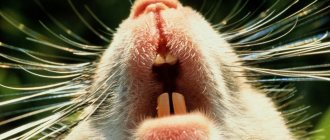The eyes of night rodents are large and convex, which gives them a charming appearance and allows them to notice a predator in time. But physiological exophthalmos (bulging eyes) significantly reduces the protection of the organ of vision. The hamster can easily injure it or prick itself due to a delayed blink reaction. The central zone of the cornea is poorly washed by tears and is little wetted, so even a minor injury can lead to an ulcer. Hamsters are active at night and are not adapted to bright light. A bright flash or direct sunlight can damage hamsters' already weak vision.
Due to the pet’s small size and independent nature, the owner often discovers the problem in an advanced stage: the hamster has one eye closed, or both eyelids are glued together with pus, one is larger than the other, and so on.
Causes of eye diseases
Hamsters are susceptible to various infections and age-related diseases. Eye diseases are quite common among them. If you don’t know why the hamster doesn’t open its eye, look into this issue. This will help to heal the fluffy faster and avoid illnesses in the future.
- Unsanitary conditions. The most common cause of eye infections in hamsters. In a filler that has not been changed for a long time, pathogenic microorganisms multiply at incredible speed. But homa likes to burrow into the litter, so the likelihood of picking up an infection is very high.
- Allergy. If you feed your pet all sorts of exotic foods, then don’t be surprised that your hamster’s eyes are watery. This is a common allergic reaction. Allergies can also be triggered by the chemicals you used to wash the cell.
- Injuries. Injuring the eyes of hamsters is not that difficult. The animal can prick its eye with hard hay or drive a piece of sawdust litter under the eyelid. But if a hamster has one eye closed, most likely the animal’s cheek is damaged: it is so swollen that the eye closes by itself.
- General decrease in immunity. It has been noted that conjunctivitis in hamsters is often accompanied by pneumonia, tuberculosis and viral diseases of the respiratory tract.
There are also senile changes in the organs of vision, in which white spots appear.
If it doesn't open
Only the attending physician - a veterinarian - can help establish the correct diagnosis. Therefore, if the hamster’s eyes do not open, you urgently need to take your pet and take it for examination.
If for some reason you are currently unable to visit a veterinarian, you will need to do the following:
- A hamster whose eyes are sour, inflamed and completely closed should be quarantined, that is, separated from his fellow cagemates.
- The animal’s home, as well as all accessories that are in it, must be disinfected (a solution of potassium permanganate or soda solution can be used as an antiseptic).
- At home, you can drip a rodent's eye with special Albucid drops, which are sold in any pharmacy. You need to drip every day so that your hamster's inflamed and swollen eyelids fully open.
But before instilling this medicine, you need to treat the inflamed area with saline solution. Soak a cotton swab in the warm solution and drop it onto the inflamed area. In the absence of saline solution, you can use ordinary boiled water. Its temperature should not be higher than room temperature. With suppuration, bleeding and protrusion of the organs of vision in hamsters, the drug “Tsiprovet” helps very well.
Common symptoms of eye diseases
How can you tell if your Homa has problems with his eyes? It is necessary to examine the animal daily so as not to accidentally miss the disease. You should be concerned if:
- Hamsters' eyes are wet;
- swollen eyelids;
- mucous discharge from the eye appeared;
- the pet does not open its eyes or at least one of them;
- fur began to come out on the eyelids;
- The hamster's eye turned white in the pupil area.
Cloudiness of the pupil is typical for old animals, but other symptoms occur in pets of all ages. Most often they are caused by diseases of bacterial origin.
Bulging eyes
This is more likely not a disease, but a consequence of injury to the eyeball, which has a bad effect on the general condition of the animal. A hamster can damage its eyes both in the fight against other rodents for survival and from dangerous objects contained in the cage - wood chips, sawdust, wire, etc.
As a result of injury, the invading pathogenic bacteria begins to rapidly multiply, penetrating even under the eyeball itself. Such a pet will most likely face surgery to remove the damaged organ. Otherwise, the bacterial infection can develop further, affecting the entire body. Then the rodent can no longer be saved.
Age-related changes
If a hamster has a white spot on its eye, this indicates that the animal is beginning to undergo senile changes in its body. This disease is called cataracts and occurs in all mammals. It is caused by clouding of the lens. More often the eye becomes cloudy in the area of the pupil, less often along the periphery. At first the spot is gray, gradually turning white.
The development of cataracts in rodents is caused by stress, eye injuries, and sometimes the disease results from other ailments: diabetes mellitus in dzhungarik, food poisoning. The risk of cataracts increases if the animal's cage is regularly exposed to the sun.
Unfortunately, there is no cure for this eye disease in hamsters; it is impossible to get rid of it. But there are tips that will help significantly reduce the risk of developing the disease:
- Do not leave the animal's house in the sun.
- Don't give your home a lot of sweets.
- Make sure your diet is rich in carotenoids; they are found in carrots, parsley, zucchini and other foods of plant origin.
- Treat your animal's eye infections promptly.
In rare cases, furry cats have congenital cataracts. What to do if your pet has an eyesore? Hamsters don’t have very good eyesight anyway, but with this problem they can see completely poorly. Therefore, do not clutter the cage with furniture, as this can lead to injury.
Injuries
There is a reason why little pets are prohibited from running around the apartment without a special ball. Animals can get injured even while in a cage, including damage to the organ of vision. The injury is characterized by damage to one eye. A hamster may get hurt in a fight when animals are kept together, or stumble upon a sharp straw in the hay.
Corneal injury
When the damage is fresh, it is difficult to understand what is wrong: the hamster’s eye is watery, he squints, and does not let him see whether the eye is red. The animal cannot say about it, but after the injury the eye hurts a lot. Due to pain, behavior changes: the pet becomes nervous, inactive, and hides. When the cornea or other structures are injured, a secondary infection quickly develops and pus appears. The eye turns sour and the problem becomes obvious.
When a hamster's eye festers and does not open, for examination it is necessary to first clean the eyelids. Do not use liquids that are not safe for the mucous membrane of the eye, such as hydrogen peroxide. If the eyes are stuck together, the eyelids are not separated by force, but are patiently soaked. The best harmless remedy is warm saline solution or boiled water.
Use a sterile gauze swab or cotton pad. You can’t use regular cotton wool: small fibers remain on the eyelids and eyelashes, causing irritation. To avoid infection, you need separate tampons, at least two.
When a scratch heals, a scar may form on the cornea, and then a white spot is noticed on the hamster’s eye.
Sometimes, after removal of the pus and examination, a wound is discovered on the eyelid, but the eye itself is unharmed. Then an antibiotic eye ointment (Tetracycline) is applied to the wound twice a day. You cannot use regular ointment.
Abscess
In addition to injury, a local abscess known as a stye may occur on the eyelids. The abscess may look like a pimple, a lump on the edge of the eyelid. Redness and soreness appear. After the lump is opened, the pus flows out and recovery occurs. If your hamster has a sore eye, instill antibacterial drops or apply ointment. You can open a mature abscess with a sterile needle to speed up the process.
Blunt trauma
If the animal is accidentally crushed, or if it falls from hands or furniture, blunt trauma to the eye is possible, accompanied by damage to the structures of the organ of vision and hemorrhage. A few hours after the accident, the blood has settled and the eye appears red. Hemophthalmos (blood in the vitreous) is accompanied by loss of vision .
At home, it is impossible to determine how badly the pet damaged its eye, but if the hamster’s eye pops out after a fall, the prognosis is unfavorable. First aid is cold (a napkin moistened with saline solution) and antibacterial ointment, which will prevent the cornea from drying out if the hamster’s eye is so swollen that the animal cannot close its eyelids.
Conjunctivitis
Inflammation of the mucous membrane of the eye occurs most often in hamsters. Usually, not one, but both eyes are affected.
Causes:
- mechanical injury;
- ingress of sand, dust (poor-quality bedding, walking around the apartment);
- irritation from chemicals, gases (ammonia in the toilet corner, household chemicals, hairspray);
- infection (viruses, bacteria);
- allergy.
In case of allergies and eye irritation from dust, the discharge will be transparent. With infection - cloudy, and then purulent (greenish, yellow). Conjunctivitis in a hamster is always complicated by a bacterial infection, especially when the bedding is changed infrequently. Then you can see that the hamster’s eyes are festering.
Symptoms of inflammatory eye problems are always the same:
- expirations of various nature;
- signs of pain;
- fear of bright light, squinting of eyes;
- changes in appearance (enlargement or reduction of the eyeball, swelling of the eyelids).
Treatment
For eyeball injuries and conjunctivitis in hamsters, treatment will be similar.
Conditions of detention
The bedding is replaced with white paper towels. Hay and sawdust are removed from the cage. Cleanliness is maintained and accessories are disinfected with hot water and soap. The cage is placed in twilight, avoiding sunlight or artificial bright light.
Treatments
Discharge is removed as needed (3-4 times a day) with a sterile swab. Use warm liquids: saline solution or an aqueous solution of furatsilin for purulent discharge. If there is no improvement, the question arises: what to do if a hamster’s eye festers. If after a couple of days of washing with furatsilin the leakage continues, use drops with a broad-spectrum antibiotic: Floxal or Tobrix, 1 drop in each eye 4-6 times a day for 5 days.
Eye drops do not last long when opened. When you finish treatment, write the date of first use on the bottle or throw it away. Expired drops will not help your pet, so there is no point in using Levomycetin drops found somewhere in the medicine cabinet.
Popular among the people, washing with tea leaves and chamomile decoction is not a treatment, but only a hygienic procedure. In a situation where your pet has a swollen eye, it is better to ask your veterinarian what to do and how to treat it.
Systemic antibiotics (Baytril) are of no use when your hamster has an inflamed eye. The eyeball is impermeable to antibiotics and other substances (blood-ophthalmic barrier). Even with a strong purulent process, local treatment is most effective: eye drops.
At night, a rare owner is ready to wash and put drops in the eyes of a sick pet, so with purulent conjunctivitis in the morning the hamster does not open his eyes: the eyelids are stuck together with secretions. If a large gap between treatments is expected, instead of drops, generously apply ointment with the same antibiotic (Floxal ointment).
panophthalmitis develops - purulent inflammation of the entire eye. Then the only measure is to remove the eyeball and suturing the eyelids. A dzhungarik may even die with such a problem, but more often the eye leaks out and the animal gradually heals on its own. Enucleation is practiced when the eyeball falls out due to injury.
Bacterial infections
If you notice that your hamster's eyes are festering, it means that your pet has picked up a bacterial infection. Its common pathogens are spherical and rod-shaped bacteria: staphylococcus, clostridium, E. coli, streptococcus, etc. Once under the eyelid, they begin to actively multiply. To fight them, the body sends protective cells - leukocytes, various enzymes and other substances that destroy the bacterial wall. As a result, pus is formed - a viscous substance containing living and dead bacteria.
There are several bacterial eye diseases. If your hamster's eye is festering, it could be one of the infections discussed below.
Conjunctivitis
The disease is not dangerous if left untreated. The disease in most cases is caused by pathogenic microflora and only occasionally has an allergic origin. First, the animal’s eyes begin to water; at this stage, few are able to recognize the disease. Then more reliable symptoms appear:
- The hamster's eye is rotting. Pus is a yellow or greenish mass that collects in the corners of the eye;
- the eyelids become inflamed and may swell;
- the palpebral slits narrow until the eye closes completely;
- the animal becomes apathetic and may lose appetite.
If a hamster's eyes fester, it is important to start treatment on time, since pathogenic flora can spread to the eyelids from the inside and outside, the hair will begin to come out, and the pet will be very uncomfortable. As a result of advanced conjunctivitis, the eyes may close completely, and this is a huge stress for the animal.
Few people know how to treat conjunctivitis in domestic rodents and whether it is possible to use a human first aid kit. Of course, it is better to make an appointment with your veterinarian to get professional advice. But if this is not possible, you will have to care for the fluffy yourself.
Conjunctivitis
This disease affects not only people, but also animals - the hamster is no exception. Moreover, the treatment of such a disease is quite difficult for domestic hamsters. In some cases, if timely measures are not taken, the animal may simply die.
Conjunctivitis is the initial stage of one of the most serious pathologies in an animal. If a hamster's eye festers and does not open, perhaps some kind of infection or virus has settled inside its body. At an advanced stage, conjunctivitis can cause the development of keratitis, and then it is not far from such a pathology as protrusion of the cornea. What to do in such a situation so as not to trigger the disease?
Therefore, if a hamster’s eye is swollen, very swollen, and its owner does not pay attention to his pet, first the rodent may go blind, then die completely.
The same outcome awaits those pet rodent lovers who do not approach the treatment of their animals competently. Remember that any treatment prescribed independently can result in disastrous consequences for your own household.
With a timely response to an animal's illness, you will never have a question about why the hamster's eye popped out or why it was completely closed and festered.
an eyesore for a hamster
My Syrian hamster (1 year old, female) today developed a film on the mucous membrane of her eye. It is gray, slightly cloudy, looks like a thorn or some kind of drag, and covers the entire eye. In this case, the eye opens completely, as usual, there are no pathologies on the skin around it. The hamster lives alone, in a cage with a house, a wheel and a drinking bowl. There is sawdust on the floor. In recent days, in addition to dry food, she gave pumpkin seeds, raisins, lettuce, walnuts, and cottage cheese. The hamster's behavior is normal: eating, running, washing.
Tell me, could this be an allergy, for example, to seeds? They were salty on the outside, but I gave them already peeled.
Only registered users have the ability to start new topics. Register and log in to the site by entering your username and password on the right side of the window, and you can start a new topic.
Before visiting the forum, read the topic: “How to properly consult a veterinarian,” as well as the list of answers to frequently asked questions, this will help you save your time and get an answer to your question faster. Pay special attention to the document: Symptoms of animal diseases. Perhaps in your situation you cannot expect an answer on the forum, but you need to urgently call a doctor or take the animal to a veterinary clinic!
Before joining the forum, read the following sections, this will help save your time and quickly get an answer to your question:
Attention! Pay special attention to the document “Symptoms of Animal Diseases”. Perhaps in your situation you cannot expect an answer on the forum, but you need to urgently call a doctor or take the animal to a veterinary clinic!
Source
Main reasons
Rodents are often susceptible to infectious and age-related eye diseases. If it is difficult for a hamster to open its eyes, it is imperative to figure out the cause of the problem, otherwise irreversible consequences will begin.
Allergy
Tearfulness can occur due to the consumption of exotic fruits and other unusual delicacies. Also the cause is the detergents used when processing cells, as they contain a large number of chemical compounds.
Unsanitary conditions
One of the common causes of eye diseases in rodents. Over time, microbes begin to multiply in the litter and bedding. And hamsters often sit and hide in them from people, so it is important to periodically change them.
Trauma and injury to the cornea
Hamsters can easily injure themselves. They can prick themselves on sharp oat straws, or a small particle of filler can penetrate under the eyelids. Inflammation of the cheek is also a factor in the onset of the disease. If several rodents live together in a cage, they can be injured during a fight.
With a fresh wound, the hamster squints due to the tearing of the eye. The affected area hurts, the pet is nervous, moves little and constantly hides. If the cornea is injured, microbes may enter and the eye may become sour.
Before the examination, it is necessary to clean the eyelids. When rinsing, do not use hydrogen peroxide or other liquids that harm the mucous membrane. If your eyes are stuck together, you need to soak your eyelids; under no circumstances try to force them open.
The easiest way is to soak it with a cotton swab dipped in boiled water. You cannot use regular cotton wool, as its fibers can remain on the eyelids or eyelashes and cause re-infection.
It happens that the eyelid is injured, in which case you need to lubricate it with tetracycline ointment twice a day.
Weak immunity
Eye ailments in hamsters can be in addition to tuberculosis, pneumonia and viral infections of the respiratory tract.
Eye diseases in hamsters
Problems in rodents can be identified by several signs:
- swelling and non-opening of the eyes;
- wet eyelids;
- tearfulness with purulent discharge;
- the appearance of a stye or bump;
- hair loss on the eyelids;
- redness of the inflamed area.
Based on these signs, it can be determined that the animal has a foreign infection. Due to the disease, rodents may stop eating and drinking. All eye ailments are divided into two groups: those resulting from injury and infectious.
Conjunctivitis
This is a disease associated with inflammation of the mucous membrane. This is the most common disease that affects both eyes.
There are several causes of conjunctivitis: infection and infection from another rodent. Without timely treatment, the disease progresses quickly: hamsters have poor spatial orientation, become spreaders of bacteria to other rodents, and may die.
Another reason is an allergy to food or “unhealthy” treats, for example, sweets, baked goods, etc. It is important to give hamsters a special balanced food that does not cause allergic reactions.
The main symptoms of conjunctivitis:
- redness;
- suppuration;
- increased moisture in the eyelids;
- restless behavior of the rodent;
- increase in body temperature;
- sticky eyelids.
If there is at least one symptom of the disease, it is considered that the infection has already entered the body. The discharge of pus indicates a progressive disease. If possible, it is advisable to show your pet to a veterinarian.
For home use, use a proven product - Albucid eye drops. 1 drop in both eyes three times a day. Positive dynamics are monitored from the third day of use. Along with instillation, you can wipe your eyes with a cotton pad once a day. It is not recommended to use other methods and means.
- periodic change of litter;
- surface disinfection;
- monitoring the condition of the hamster;
- provision of quality food and clean drinking water;
- washing the cage and all rodent accessories.
Blepharitis
The cause of this disease is inflammation. The eyelids turn red and itching occurs. If not treated promptly, both eyes may close. The symptoms are the same as for conjunctivitis, but hair loss around the eye is added.
This is due to the fact that the hamster scratches the affected area. Treatment is similar to the previous disease, only tetracycline ointment is added. The main thing is to provide timely assistance and contact a veterinarian. If you have blepharitis, you need to provide your hamster with a diet and regularly disinfect the cage.
Abscess
If a rodent has a swelling of the eye and there is a clear difference in their size, then it may be an abscess. This disease is popularly called barley.
This is not a disease, but a symptom of shock - a purulent capsule that can hide deep in the hamster's body. The tissues around it become inflamed and become hot compared to other parts of the animal’s body.
- swelling of the eye;
- mucous discharge;
- inflammation of surrounding tissues;
- itching
The disease can only be cured in a veterinary hospital; it cannot be cured at home. Recovery occurs when the capsule is freed from pus.
Belmo
The disease is associated with the appearance of a light spot on the pupil of a hamster. The main factor is injury, sometimes cataracts. It happens that the stain covers the entire surface of the eye.
A veterinarian's consultation is required to determine the cause. This is a non-infectious disease and cannot be treated with medicine. The rodent will continue to live its usual life, but with a new disadvantage.
To prevent the disease, it is not recommended to place the pet’s cage in the sun and use bedding, which can harm the eyes. It is also not recommended to place hamsters that do not belong to the Djungarian species in the same cage.
Dzungarian diseases transmitted to humans
Some infectious diseases of Djungarian hamsters pose a serious danger to humans.
Tuberculosis
This disease is caused by a rod-shaped bacterium. It affects various organs, most often the lungs. Symptoms of tuberculosis do not appear for a long time. At the final stage of the disease, the hamster quickly loses weight and soon dies.
Listeriosis
The causative agents are Listeria bacteria, which enter the hamster’s body through nutrition or airborne droplets. The clinical picture depends on the form of the disease. In acute cases, the animal is depressed, does not eat, and lies motionless in the corner. Death occurs within 2-3 days.
Subacute and chronic forms of listeriosis are characterized by manifestations of nervous system disorders. The Djungarian hamster has problems with balance and coordination.
Ringworm
This disease is caused by a fungal infection. An infected hamster develops bald, rounded areas on its body. The fur in these areas looks like it has been trimmed short with scissors. Ringworm is itchy, so your hamster is constantly itching. The disease is treated with antifungal ointment.
Helminthiasis
The body of Djungarian hamsters is parasitized by flatworms, tapeworms and roundworms. Symptoms of helminthiasis:
- a sick animal loses its appetite;
- the coat looks untidy;
- disorders of the digestive tract - diarrhea, constipation;
- allergic rashes on the body;
- lethargy.
Parasitic diseases are not common in domestic hamsters and are treated with anthelmintic drugs. Most medications on the market are intended for larger animals such as cats and dogs. Therefore, the correct dosage must be prescribed by a veterinarian.
Attention! After contact with the hamster, you must wash your hands with soap. This simple precaution will help reduce the risk of contracting dangerous diseases.
Rabies
This disease is extremely rare in domestic hamsters. For a dwarf to become infected, it must be bitten by a sick animal. After purchasing the animal, it is advisable to observe it for 7-10 days, since during this period of time the rodent infected with rabies will die.
Attention! Rabies is transmitted through saliva and has no cure. If a person is bitten by a sick animal, they should go to the hospital as soon as possible and undergo rabies vaccination.
Salmonellosis
The disease is caused by bacteria of the genus Salmonella. It manifests itself with the following symptoms:
- diarrhea, vomiting, weakness;
- trembling in the body;
- conjunctivitis;
- bloody discharge from the nasal passages;
- exhaustion.
Young hamsters quickly die from salmonellosis. A person can become infected from a pet if they neglect the rules of personal hygiene - do not wash their hands after contact with the animal or cleaning the cage.











